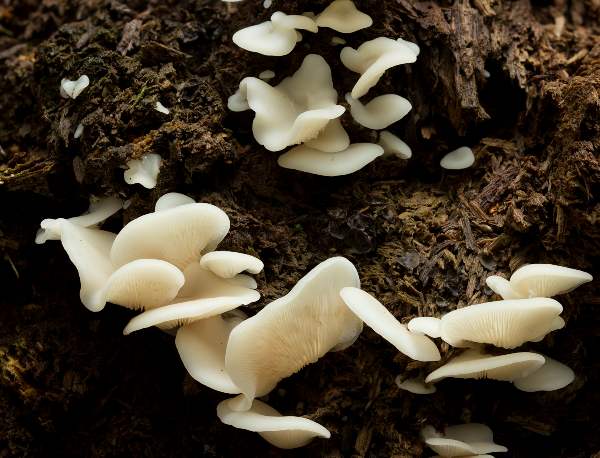Crepidotus applanatus (Pers.) P. Kumm. - Flat Oysterling
Phylum: Basidiomycota - Class: Agaricomycetes - Order: Agaricales - Family: Inocybaceae
Distribution - Taxonomic History - Etymology - Culinary Notes - Identification - Reference Sources
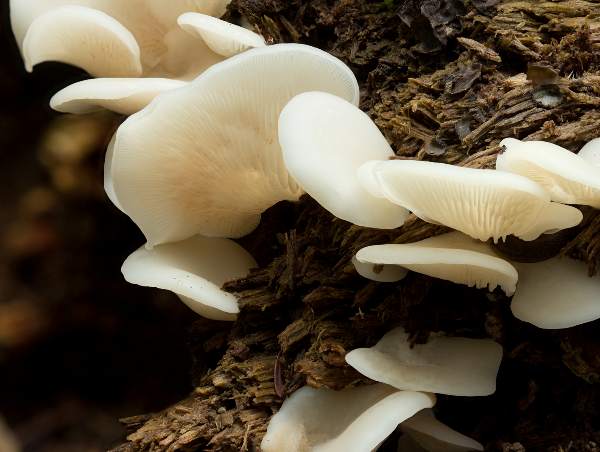
Crepidotus applanatus is a tiny, kidney-shaped fungus that appears on dead wood of deciduous broadleaf trees. The attachment is sessile (having no stem).
Distribution
Uncommon but quite widely distributed in woodlands throughout Britain and Ireland, this mushroom occurs across mainland Europe and is also recorded in many other parts of the world including North America.
Taxonomic history
The Flat Oysterling was described in 1796 by Christiaan Hendrik Persoon, who established its basionym when he gave it the binomial scientific name Agaricus applanatus. It was German mycologist Paul Kummer who, in 1871, transferred this species to the genus Crepidotus, whereupon it acquired its currently accepted scientific name Crepidotus applanatus.
Synonyms of Crepidotus applanatus include Agaricus applanatus Pers., Agaricus putrigenus Berk. & M.A. Curtis, and Crepidopus putrigenus (Berk. & M.A. Curtis) Sacc.
Etymology
The generic name Crepidotus comes from crepid- meaning a base, such as a shoe or a slipper (although some sources state that it means 'cracked'), and otus, meaning an ear - hence it suggests a 'slipper-like ear'. In the past mushrooms in this genus were sometimes referred to as slipper mushrooms. The specific epithet applanatus means of a flattened (planar) shape.
Identification guide
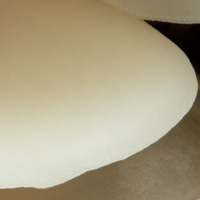 |
CapPetaloid, typically 1 to 4cm across, the smooth cap is initially white, turning creamy-ochre with age. The fruitbody is stemless and attached to its substrate via the upper (infertile\0 surface of the cap. When wet the cap margin is translucently striate. . |
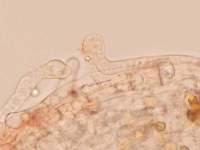 |
PileipellisThe pileipellis is a cutis with hyphae 3-9μm in diameter and with some erect terminal elements (left) with the rounded apex expanded to 11μm diameter. Broadly ellipsoidal, smooth, 11.5-16 x 7-10μm; hyaline.
|
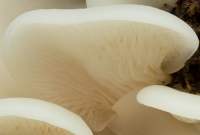 |
GillsThe gills, which radiate from the point of attachment, are crowded. Whitish at first, they gradually turn pale brown. StemThis woodland mushroom has no stipe (stem) at all. |
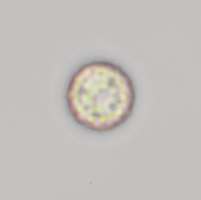 |
SporesGlobose, 4.5-7 x 4.5-6.5μm, ornamented with minute spiny warts.
Spore printPinkish buff. |
Odour/taste |
Not distinctive. |
Habitat & Ecological role |
Saprobic, dead deciduous wood. |
Season |
July to October in Britain and Ireland. |
Similar species |
Crepidotus cesatti has a scalloped margin. Crepidotus mollis has a transparent cuticle layer that is evident when the cap is stretched. |
Culinary Notes
This summer and autumn species is considerd to be inedible.
Many authorities give this genus family status as Crepidotaceae, while others include the genus Crepidotus within the family Inocybaceae; this should be a warning that these little fungi are not for eating, as some Inocybe species are deadly poisonous. Care is needed, therefore, when collecting edible Oyster Mushrooms Pleurotus ostreatus, to avoid accidentally gathering Flat Oysterlings instead.
Reference Sources
Pat O'Reilly; Fascinated by Fungi, 2nd edition, 2016.
British Mycological Society. English Names for Fungi.
Dictionary of the Fungi; Paul M. Kirk, Paul F. Cannon, David W. Minter and J. A. Stalpers; CABI, 2008
Taxonomic history and synonym information on these pages is drawn from many sources but in particular from the British Mycological Society's GB Checklist of Fungi.
Acknowledgements
This page includes pictures kindly contributed by David Kelly.
Fascinated by Fungi. Back by popular demand, Pat O'Reilly's best-selling 450-page hardback book is available now. The latest second edition was republished with a sparkling new cover design in September 2022 by Coch-y-Bonddu Books. Full details and copies are available from the publisher's online bookshop...

